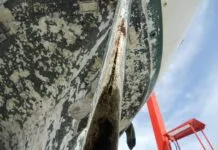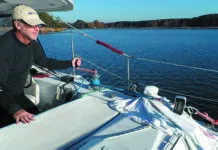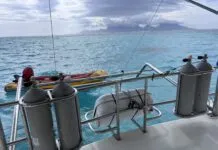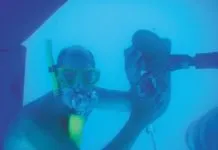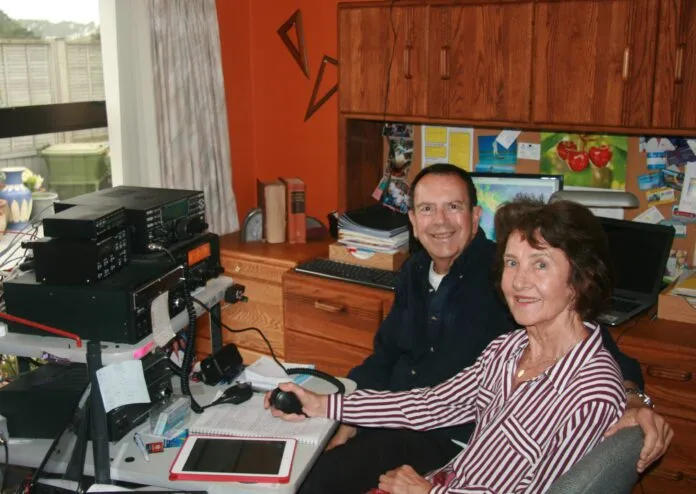
Speaking with Patricia Dallas and David Sapiane of Gulf Harbour Radio is a little like speaking to a great-aunt and uncle. Like someone who’s got your back and wants you to succeed. For cruisers around the world, many can relate. In an age where technology often distances us, this couple reminds us of the power of human connection combined with maritime expertise.
Working from a small studio at their home in Whangaparāoa, north of Auckland, New Zealand, Patricia and David manage a daily maritime broadcast reaching far beyond local shores. And what they offer is more than just technical expertise. What began in 2012 as a modest radio broadcast has blossomed into an indispensable resource for sailors navigating the complex waters of the South West Pacific.
METEOROLOGY AND RADIO OPERATOR TALENT COMBINED
The heart of their service lies in providing timely weather forecasts and navigation suggestions, crucial for voyagers embarking on the Pacific crossing. “The passage to New Zealand can be fraught with difficulties,” notes Patricia, pointing to the region’s notorious weather patterns. “David’s expertise, especially in weather, has been invaluable for sailors planning their journey.”
Both have a background in science and a love of the sea. David studied meteorology as part of his degree at University of Florida. He has boated since a child and received further marine training when with the United States army. Patricia, a New Zealander, learned her radio skills from her father and has been a ham radio operator for several decades. The couple cruised around the world for 15 years and know the South West Pacific very well, so the establishment of their Gulf Harbour Radio station was a perfect way of combining their interests.
Each day during the cruising season (May through November) the couple provide radio contact with cruising yachts and help with their understanding of the weather. “We want people to enjoy their trip, so we find our service helps sailors give it the attention it deserves.”
LIVE STREAMS FOR LOVED ONES ON LAND
With over 100 boats on their contact list each year, the pair offers a unique blend of broadcasting weather forecast data, and live-streaming at the same time via their YouTube channel: Gulf Harbour Radio. “We don’t know how many are listening on the radio; we only know who calls in,” says Patricia. “Often we are that additional check and human touch. And sailors benefit from hearing reports from others on a similar route.”
The streaming side has really grown in the last couple of years, much to the couple’s surprise. “We know that even when there may be only a dozen boats listening live, by the end of the day over 100 have tuned in! We currently have 300 subscribers. Many are friends and family of boats at sea who are relieved to hear that all is well. Some are fellow cruisers keeping track of conditions. Others are just interested in the cruising life and maybe preparing themselves for their own adventure.”
A CALM VOICE WHEN THE GOING GETS ROUGH
Any sailor’s first real worry is the erratic nature of the weather. David knows this, and guides boats away from approaching storms. They are the knowledgeable eyes and ears looking out across the whole situation.
“Recently we were in contact with a European sailor who was only sailing 3.5 knots in light winds—‘I like to sail,’ he said,” explains Patricia. “He was strongly advised to turn on his engine so that he could arrive in Opua (New Zealand) before a significant storm hit him. We were relieved and thrilled to see his progress each night—with the engine on. He made it, with a few hours to spare!”
Their broadcasts not only cover weather updates but also serve as a lifeline for sailors in distress. “We’ve had boats in dire situations,” she recounts. “When things go wrong, problems seem to multiply. Remember that many boats are short-handed so when parts break and conditions are rough, tiredness can negatively affect decision-making. It’s good to have someone who can look at the weather and sea conditions and make sensible suggestions. A calm voice helps, and we are closely in touch with the New Zealand Rescue Coordination Centre when the need arises. We give them a heads up so that they can monitor a boat 24/7.”

COMMUNITY AND HUMAN CONNECTION IN THE HEART OF THE SEA
Beyond the technicalities of maritime safety, the pair’s broadcast also fosters a sense of community among sailors. “We’ve met some amazing people through this,” she shares warmly. “They tune in daily, sometimes from far flung corners of the ocean, just to hear a family voice and connect with fellow sailors. One pair told us it’s the highlight of their day!”
There’s something quite comforting about that. It really is a big family out there. When someone calls in with a question to the fleet, it is answered very quickly. If things are quiet, passage-wise, Patricia will cover a bit of world or local news. Near the end of the season the pair discuss where to go and what anchorages are worth exploring in New Zealand.
In an era dominated by satellite communication and high-tech navigation aids, the couple offers something unique and invaluable: human connection. “Our service isn’t just about data; it’s about understanding each sailor’s journey,” she reflects. “Many cruisers tell us they appreciate having a trusted voice to turn to, especially when conditions turn challenging. We thought that with many boats using Starlink that our service would not be needed. However even with numerous sources of information there is the all-important interpretation of weather models, and the feeling of being part of a caring community that many appreciate.”
And when they’re not on the radio, David and Patricia enjoy adventures on their own boat, Chameleon, a Moody 47. “Cruising keeps us grounded,” Patricia muses. “It’s our time to recharge after a busy season helping others. And we get to meet and sometimes stay in touch with some of the folk we talk to on air. ”
Their suggestions for aspiring ocean voyagers is simple, yet wise: “Plan meticulously, listen to weather experts and stay connected,” Patricia advises. “Whether it’s through our broadcasts or other resources, sailors should never underestimate the power of preparation and community support.”
For more information, visit ghradio.co.nz









